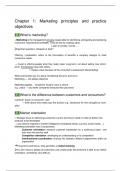Chapter 1: Marketing principles and practice
objectives
1.1 What is marketing?
= Marketing is the management process responsible for identifying, anticipating and satisfying
customers' requirements profitably. They do this by creating value.
↳ gain in society, money, …
❕Important question: cheapest or best?
Offering / proposition: refers to the formulation of benefits a company designs to meet
customers needs.
→ Invest in offering people what they really need. Long-term, not about selling now (short-
term). Exchanging value with others.
= creates value because of the consumer’s assessment (beoordeling)
What economists say: it’s about considering the pro’s and con’s
Marketing → not always objective
Marketing applies… Anywhere “buyers” have a choice
e.g.: place → city wants companies because they pay taxes
1.2 What is the difference between customers and consumers?
customer: buyer vs consumer: user
→ think about who really buys the product e.g.: deodorant for men (bought by mom,
wife)
1.3 Market orientation
= Strategic focus on delivering customers current and future needs in order to define new
products to be developed.
→ you need to respond to market intelligence (verbalised needs, surveys, social media,…)
Marketing orientation has 3 components:
- Customer orientation: measure customer satisfaction on a continuous basis and
train front line service staff
- Competitor orientation: developing an understanding of its competitors
- Interfunctional coordination: sharing info between different departments within an
organisation
➜ long-term profit focus, they get better at market sensing
❕You don’t have to please all customers, just create profit. Not everyone is able to do market
orientation, sometimes very difficult.
,1.4 Marketing’s intellectual roots
Influences:
- Industrial economics
- Psychological
- Sociological (behaviour of groups of people, demographics)
- Anthropological (systematic study of humanity, understanding evolutionary origins)
- Computer science
1.5 Difference between sales and marketing
Sales is about ‘product push’ (short-term) while marketing is about ‘product pull’ (long-term)
→ the differences are blurring when applying Key account management (KAM)
(fast fashion: belangrijk niet altijd dezelfde kleren, fomo→ geen collectie missen, belangrijk
voor mensen hun “needs”)
1.6 What do marketers do?
Core: generate customer insight, marketing strategy
→ Technically they do this by creating a brand, digital integration, customer experience, ….
1.7 Marketing as exchange
❕Customers and stakeholders can bring other value, other than purchases.
, E.g.: publicity, loyalty, upselling (to sell them something more expensive), cross selling (to
sell them extra product that they can maybe combine with their product)
1.8 The marketing mix and the 4 Ps
⇩
Product Price Place Promotion
→ perspective of the company
1.9 The extended marketing mix
When there is a service component, there are also other things to consider.
Physical evidence: the importance of tangible components of services.
Process: the importance of service delivery.
People: the importance of good service personnel who interact with customers.
❕New P: Personalisation → collecting data to identify patterns and to more effectively target
potential customers
E.g.: Netflix → personalisation elements: recommend shows based on previous shows you
watched, they know where you are during an episode, profile picture, “98% matched”, also the
order in which the lines are placed
1.10 Relationship marketing, service-dominant logic and co-
creation
Customer relationship marketing (CRM) = Process of gaining info of individual customers
and building customer relationships by delivering superior value.
Loyal customers…
… will increase their purchase over time, are cheaper to promote to, refer to others
❕Use touch points to gather much info
↳ payment, surveys, website vitis, …
⇨ Marketing automation ≠ CRM → CRM is mostly based on sales purposes and the
automation mostly searches for customers
Customers lifetime value = predicting all of the value a business will derive from their entire
relationship with a customer
e.g.: banks invest in young people
Service-dominant logic = Sees service as the fundamental basis of exchange.
❕Mostly same products so service makes the difference
Co-creation = product or service design process in which input from consumers plays a
central role from beginning to end.
E.g.: propose some flavours of lays and the customers can choose which one they want
them to make
, 1.11 Different perspectives
1. The consumer goods perspective
→ has dominated the history of marketing
Convenience goods: purchased frequently with minimum effort
Shopping goods: purchased selectively
Specialty goods: purchased highly selectively
2. The services perspective (more detail in chapter 5)
3. The business-to-business perspective (more detail in chapter 4)
1.12 Marketing's impact on society
+ : Marketing of non-profits, innovations
- : frequently criticise to be unethical
Chapter 2: The Marketing environment
= everything outside marketing that influences marketings abilities to build and maintain
successful relationships with selected clients
3 levels:
- Internal environment (R&D, finance department, CEO, logistics → everything within
the company)
- Performance environment (social media, competition)
- External environment
2.1 Understanding the external environment
DESTEP analysis
A) Demographic environment
→ study of the human population
Population boom
Increasing migration and connectivity
Increasing urbanisation (ikea for example invest in smaller stores in the city because that’s
where the people are)
Ageing population (invest in retirement homes)
Changing households (not mom, dad, kids)
B) Economic environment
→ factors that affect consumers buying power and spending patterns
C) Socio-cultural environment
→ forces that affect society's basic values and norms, changing in nature of households,
lifestyle, reflects in cultural part
Global consumer culture: consumers purchase across borders, offline and online.
One-stop shopping: going to one store for everything you need e.g. ikea, walmart
Now: increased concern with health and fitness (vegetarians, month without alcohol,...)
D) Technological environment




